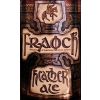Williams Brothers Brewing Company - Fraoch Heather Ale
-
ABV:
5.00% -
Serving Temperature:
45-50° F -
Suggested Glassware:
Pint Glass or Mug
Scotland is a land boasting an enormously rich brewing history, but unfortunately many of the country’s own unique beer styles (with a myriad of unusual ingredients) faded away out of mind generations ago. However, two brothers have managed to rescue several of these very special beers through considerable research and dedication.
One fateful day in 1986, a lady walked into the Williams’ homebrew shop in Patrick, Scotland, bearing a translated recipe for a long-forgotten brew known as ‘Leanne Fraoch’, or Heather Ale, dating from the 1600s. After perfecting the recipe at the homebrew-sized level, Bruce and Scott Williams decided that it was not only good, but worthy of becoming the flagship beer for a new brewing company, and in 1988 they brewed their first batch on a much larger (but still very small by commercial standards) 5 barrel system in Taynult, Scotland. While enough to supply a handful of pubs across the country, after a while it became clear that it was woefully inadequate to meet the increasing demand, so the brothers moved their expanding company into a larger brewery in Alloa, a city along the Firth of Forth in central Scotland.
It was at this time that they began branching out, rediscovering and re-introducing four more “Historic Ales of Scotland.” Each of these wonderfully unique brews contains ingredients from the nation’s forgotten brewing tradition, including such things as elderberries, pine, spruce, seaweed, gooseberries, bog myrtle, and meadowsweet.
So what’s with all the weird ingredients, you ask? Well, brewing in Scotland long pre-dates the use of hops as a way to add bitterness to beer. When beer is brewed, sugars are released from malted grains, yielding a sweet liquid known as “wort” (pronounced “wert”) that is basically beer before fermentation. After fermentation, in which yeast transform much of that sugar into alcohol (and CO2), residual sweetness remains in the beer to varying degrees depending on the style. To balance the sweetness, a bittering agent is used as an offsetting flavor. In modern times, hops are used almost exclusively for this task, but for thousands of years brewers used all sorts of ingredients like bark, roots, fruit, spices, and flowers (it’s worth remembering that hops are flowers, so some of these ingredients are really not any stranger than our contemporary bittering additive). While we have evidence of the use of hops in brewing as far back as 1079, British beers weren’t widely hopped until the early 16th century. As varied as beer styles are today, imagine the incredible range of flavors offered by ancient brews, with so many cultures using so many varied ingredients!
Okay, back to the Williams Brothers. In 2004, brewing operations were moved into a larger facility in Alloa, where they remain to this day. With more space to brew, they decided to expand their offerings to include a large number of more “Contemporary” beers like an 80/- (80 shilling) Scottish Ale, IPA, Porter, and more. For additional info on the brewery and both of their well-regarded Historic and Contemporary collections of brews, visit their website at www.williamsbrosbrew.com.

Unmatched Variety by style, brewery & country
Choose from Five different Beer Clubs offering unmatched variety by brewery,
country of origin, and beer style to suit your specific tastes.


